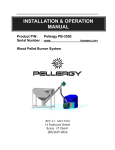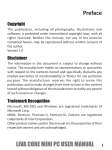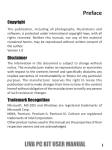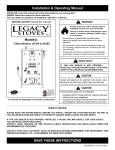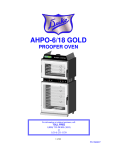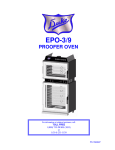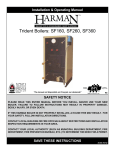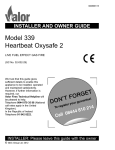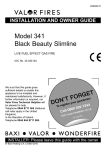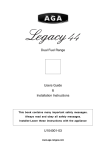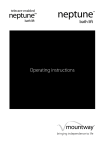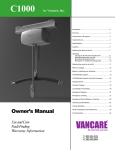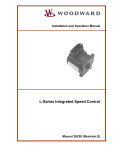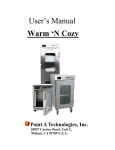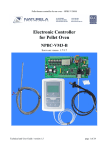Download INSTALLATION & OPERATION MANUAL
Transcript
INSTALLATION & OPERATION MANUAL Product P/N: Pellergy PB-1525 Serial Number : ________________ Wood Pellet Burner System REV 1.0: OCTOBER 2011 16 Railroad Street Barre, VT 05641 (802)659-4866 www.pellergy.com www.mywoodpelletsolution.com PB-1525 Wood Pellet Burner System: Installation and Operation Manual Rev 1.0, OCTOBER 2011 Table of Contents INSTALLATION & OPERATION MANUAL Introduction Chapter ONE: Safety Chapter TWO: Installation Installation of the PB-1525 Wood Pellet Burner System Installation of the Pellet Conveyor Boiler/Furnace Room Ventilation and Maintenance Measuring Chimney Draft Electric installation Chapter THREE: System Setup & Operational Overview Controller User Interface Description System Operational Description System States System Setup Filling the Conveyor Setup of the Start Feed Value Setup of the Burner Firing Rate Setup of the Initial Combustion Blower Setting Value Running the Burner for the First Time Burner Cycles Setting the Cleanout Cycles Installation and Setup of the Flue Gas Temperature Sensor Chapter FOUR: Maintenance General information Cleaning burner chamber Troubleshooting Burner Servicing Technical Data Available Replacement Parts Warranty and Installation Doc Burner Measured Values Burner Settings Burner Measured Values Burner Settings Installer Note Page & System Drawings 1 3 4 6 10 13 17 18 19 26 26 27 27 35 38 40 42 44 44 45 46 46 47 47 49 51 56 57 58 59 60 60 62 62 64 Page 2 of 67 PB-1525 Wood Pellet Burner System: Installation and Operation Manual Rev 1.0, OCTOBER 2011 Introduction Congratulations on your purchase of a PB-1525 Wood Pellet Burner System! This manual is provided to give you an overview of the system and to provide important instruction as to the installation, operation and maintenance of the system. In order to ensure years of safe, trouble-free operation, please follow the guidelines and instructions set forth in this manual. The PB-1525 wood pellet burner system is intended for installation with fully approved, regulatory compliant domestic hot water boilers and furnaces including dedicated Pellergy boilers and furnaces. The PB-1525 is intended for use with ¼” Premium Wood Pellets as defined by the Pellet Fuels Institute. The Burner System uses an external pellet conveyor (auger) to deliver pellets from Pellergy and third-party external pellet bins/hoppers to burner. Following the installation of your system, your Pellergy trained certified installation professional (Certified Installer) will review with you the operation of your system, record important information as to the installed system, give you a copy of this manual and ask that you acknowledge receipt of such. If at any time you have questions or concerns, please contact Pellergy customer service, or your Certified Installer. Page 3 of 67 PB-1525 Wood Pellet Burner System: Installation and Operation Manual Rev 1.0, OCTOBER 2011 Chapter ONE: Safety Remember: Safety does not happen on its own. You must follow the instructions set forth in this manual as well as those given to you by the certified installer and mandated by applicable local, state and federal codes. Adhering to these guidelines does not ensure accident-free operation; however, not following the instruction, guidance and procedures presented herein increases the risk of loss of property, bodily injury, and even death. Please follow this manual carefully and contact Pellergy or your Certified Installer with any questions. The PB-1525 wood pellet burner system shall be installed by Pellergy trained certified installation professionals ONLY. Any unauthorized installation of the PB-1525 system voids the product warranty and may result in loss of property, bodily injury to personnel, and even death. Pellergy systems are sold only through Pellergy trained and authorized personnel. If you have purchased this system on the secondary market please contact Pellergy or your local Certified Installer for assistance in installation and important operational instruction. A listing of Pellergy trained certified installation professionals is maintained by Pellergy LLC. Please contact Pellergy customer service for an up-todate listing of professionals in your area. FOR YOUR SAFETY, PLEASE READ THIS ENTIRE MANUAL PRIOR TO INSTALLING AND/OR OPERATING THE PB-1525 WOOD PELLET BURNER SYSTEM. FAILURE TO FOLLOW THESE INSTRUCTIONS AND LOCAL CODE MAY RESULT IN DAMAGE OR LOSS OF PROPERTY, BODILY INJURY, AND EVEN DEATH. PLEASE KEEP THIS MANUAL FOR FUTURE REFERENCE Page 4 of 67 PB-1525 Wood Pellet Burner System: Installation and Operation Manual Rev 1.0, OCTOBER 2011 Overview This Safety summary, and this manual, has been prepared to ensure the PB-1525 System is installed, operated and maintained in a safe manner for personnel and to prevent unnecessary damage or loss of property. Precautions described in this and subsequent chapters should be observed during system installation, operation and maintenance. Definitions The following definitions of warnings, cautions, and notes are provided and shall be applied throughout this document: WARNING! CAUTION! WARNING: A warning identifies a clear danger to person(s) performing that procedure and personnel utilizing the system; failure to abide by a warning may result in damage or loss of property, bodily injury, and even death. CAUTION: A caution identifies risk of damage to equipment; failure to abide by a caution may result in permanent damage to the system and/or auxiliary equipment. NOTE: A note is used to highlight essential procedures, conditions, or statements that convey important instructional data to the reader. The system must be installed by a Pellergy Trained Certified Installation Professional ONLY. Never introduce a fuel other than Premium Wood Pellets into the system. There is a high risk of fire and explosion if gasoline, diesel fuel, kerosene, #2 heating oil or any other flammable liquid or material is used in the system; always avoid the use of these. Do not store combustible materials within 24” of the PB1525 burner Items may fall into an open pellet hopper and cause damage to the auger. Keep all objects clear of the pellet Page 5 of 67 PB-1525 Wood Pellet Burner System: Installation and Operation Manual Rev 1.0, OCTOBER 2011 hopper opening. NOTE Pellets other than Premium Wood Pellets may cause system damage. Use only ¼” Premium Wood Pellets as designated and by the Pellet Fuels Institute. When installed as the only automatic source of central heat within a home or business check with your existing insurance, mortgage provider, and local building codes before installing the PB-1525 wood pellet burner system. Fully understand any limitations or restrictions that may apply as to the use of a solid fuel fired central heating unit. This system provides thermostatically controlled heat that is intended to operate unattended for up to 3-4 weeks with proper maintenance and automatic burn chamber cleanout. The PB-1525 system provides an alarm output contact that can integrate to an existing or add on home alarm or automatic dial out system. Chapter TWO: Installation WARNING! The PB-1525 wood pellet burner system shall be installed by Pellergy trained certified installation professionals ONLY. Any unauthorized installation of the PB-1525 system voids the product warranty and may result in damage or loss of property, injury to personnel, and even death. The PB-1525 Wood Pellet Burner System may only be used to convert Pellergy-approved boilers and furnaces. Pellergy engineering staff works closely with our Certified Installers to ensure compatibility between the burner and the heat exchanger. The PB-1525 Wood Pellet Burner System installs through the use of a custom Page 6 of 67 PB-1525 Wood Pellet Burner System: Installation and Operation Manual Rev 1.0, OCTOBER 2011 mounting plate to the boiler front that is provided by Pellergy. An initial site survey of the intended host boiler or furnace and environment must be performed. Pellergy must provide the Certified Installer with the appropriate mounting plate for the application. The PB-1525 must be installed to fire the boiler/furnace in the same manner as the original fuel source when converting to wood pellets. In order to accomplish this, the following guidelines must be followed: 1. The system must only be used in oil and wood fired boilers and furnaces. a. Not all boilers/furnaces are good candidates for use with a Pellergy System. The boiler must be closely evaluated by a Certified Installer for compatibility. In addition to meeting local, state and regulatory codes, the boiler/furnace must accommodate ash buildup between cleanings. This ash will accumulate within the boiler/furnace. The host boiler/furnace must be easily cleaned on a more regular basis than when firing on oil. Additionally, the boiler/furnace must allow for this buildup without compromise to the combustion gas flow within the heat exchanger surfaces of the boiler. Pellergy engineering must approve of all candidate boilers/furnaces prior to conversion. WARNING! Failure to properly match a PB-1525 system with a host boiler/furnace can result property damage, injury and even death. 2. The system requires a firebox with: a. Minimum volume of 1FT3. b. Minimum depth of 12 inches as measured from the burner face to the back wall of the firebox. c. A minimum width that can easily accommodate the largest outer diameter of the PB-1525, 6 inches. 3. The burner must be installed into the firebox such that: a. A minimum of 2-inches of clearance from the opening of the burner to the floor of the firebox is provided. b. The centerline of the burner shall be positioned at the same centerline as the pre-existing oil burner to ensure proper firing Page 7 of 67 PB-1525 Wood Pellet Burner System: Installation and Operation Manual Rev 1.0, OCTOBER 2011 of the boiler or furnace. This will ensure enough volume for the collection of ash between cleanings. 4. Not all boilers and furnaces are completely compatible with the Pellergy PB-1525 system. For example, boilers designed for pressurized firebox firing on oil systems are not suitable for use with the pellet burner even if the above firebox requirements are met. In some cases, the boiler will need to be rated1.5-2.0 times larger in input Btu´s in order to gain required Btu output and handle the heat load. The Certified Installer must evaluate the total heat load requirement against the installation requirements detailed herein and apply his/her experience with the particular boiler/furnace type during the initial evaluation of the system. 5. The PB-1525 should be set up to fire an existing boiler or furnace at a maximum of 65% of the rated input firing rate of the unit. This value will account for higher excess air requirements of wood pellet combustion and serve to maintain good efficiency. Your Certified Installer will perform heat load calculations or use other methods to ensure the proper amount of heat is being provided to meet your heating needs. WARNING! Installation of the PB-1525 shall result in no permanent modification to the existing boiler or furnace. All existing safety interlocks and controls must be utilized. If the installation of the PB-1525 will require such modification as the cutting away of insulation, gasket material, steel or any other part of the existing boiler or furnace: Do not attempt to use the PB-1525 on this system. Page 8 of 67 PB-1525 Wood Pellet Burner System: Installation and Operation Manual Rev 1.0, OCTOBER 2011 FIREBOX (minimum 1FT3) BOILER/FURNACE PB-1525 BURNER Burner Centerline matches preexisting burner centerline Refractory Insulation Required Min. Firebox depth 12” Min. Clearance 2” Figure 2.1: Typical installation showing minimum internal dimensions and clearances. CAUTION! If the manufacturer’s data on the boiler or furnace to be fired using the PB-1525 Wood Pellet Burner System gives specific instruction NOT to convert the unit to solid fuel, please consult the boiler or furnace manufacturer before installation. NOTE When installing the PB-1525, take note of the surrounding area with regard to the regular maintenance of the burner. The burner requires regular maintenance and ease of access to the burner for this maintenance will be more convenient for the user. Page 9 of 67 PB-1525 Wood Pellet Burner System: Installation and Operation Manual Rev 1.0, OCTOBER 2011 The PB-1525 Wood Pellet Burner System requires the use of an existing, up to date chimney sized appropriately for the boiler or furnace used. An existing masonry or Class A metal chimney may be used provided that it meets local code. When no local code exists, follow the requirements of NFPA 211: “Standard for Chimneys, Fireplaces, Vents, and Solid FuelBurning Appliances”. Certain Canadian Codes may require the chimney be fully relined prior to installation. WARNING! If the boiler and/or furnace is not properly cleaned and maintained, chimney temperatures can approach or exceed 1000° F and create unsafe conditions that can lead to fire. Regular cleaning and maintenance routines must be followed. CAUTION! The PB-1525 should not be used in a system installed in a chimney serving multiple boilers or furnaces unless specifically allowed by local Code AND the use of an interlock system is used such that only one unit may use the chimney at any given time. The PB-1525 should not be used in conjunction with a flu damper. If a flue damper exists in the existing system, as is typical for wood fired boilers and furnaces, the damper must be removed prior to the installation of the PB-1525. The existing chimney should be cleaned and inspected prior to installation of the PB-1525 Wood Pellet Burner System. Pellergy recommends yearly cleaning of the chimney to remove the buildup of ash and maintain proper and safe system functionality. NOTE Installation of the PB-1525 Wood Pellet Burner System 1. Plan ahead. Ensure proper installation, operation and maintenance space is available before beginning installation. Ensure the PB-1525 burner can be disassembled for proper cleaning in the intended installation space. 2. Remove oil burner and oil burner mounting plate (if applicable). 3. Inspect all gaskets and mounting surfaces. Replace any gasket material that is damaged, or that is worn or deteriorated to the Page 10 of 67 PB-1525 Wood Pellet Burner System: Installation and Operation Manual Rev 1.0, OCTOBER 2011 point where a proper seal can not be made. WARNING! The PB-1525 Wood Pellet Burner System must NOT be operated with the boiler or Furnace door open! If The PB-1525 is mounted to a hinged door, an optional interlock switch is required. This interlock is intended to prevent the burner from operating with the door open. Contact the boiler or furnace manufacturer for details regarding to and availability of the interlock switch. The Certified Installer may install an interlock switch that cuts power to the burner system if the door is opened. 4. Fit the custom PB-1525 burner mounting plate to the boiler or furnace. (For specific fitting details refer to documentation included with the custom mounting plate) 5. After mounting the burner mounting plate to the boiler or furnace, inspect to ensure that the interface between mounting plate and boiler or furnace form an air tight seal. 6. Assemble the PB-1525 burner to the mounting plate. 7. Refractory material installed on the boiler door or mounting plate shall be maintained as originally installed by the boiler or furnace manufacturer to limit the surface temperature. Pellet Auger Pellet Hopper Auger Motor Electronic Controller (550LBS Capacity) Drop Tube Pellet Feed Tube Boiler or Furnace (Not Included with System, Show for Clarity) Wood Pellet Burner Figure 2.2a: System Overview Page 11 of 67 PB-1525 Wood Pellet Burner System: Installation and Operation Manual Rev 1.0, OCTOBER 2011 WOOD/OIL BOILER MOUNTING PLATE (WILL VARY BY BOILER) PELLERGY BURNER BURNER TO MOUNTING PLATE GASKET MOUNTING PLATE TO BOILER GASKET (WILL VARY BY BOILER) Figure 2.2: Burner assembled to mounting plate. Figure 2.3a below for a typical layout of a Pellergy System with a Pellergy KPA-100-5 Cast Iron, 5-Section boiler Installations will vary; however, this figure shows a typical installation with the standard 550LBS working hopper. The working hopper can be replaced by compatible bulk pellet bins for direct feed installations. Page 12 of 67 PB-1525 Wood Pellet Burner System: Installation and Operation Manual Rev 1.0, OCTOBER 2011 Figure 2.3a: Pellergy wood pellet burner mounted to a Pellergy’s 5-Section, ASME Rated Cast Iron Boiler Installation of the Pellet Conveyor When determining the location of the pellet conveyor mounting position, the location of both the PB-1525 burner and the pellet hopper must be considered 1. The conveyor is designed to be hung from a single-point overhead anchor. Inspect the overhead in the vicinity of the PB-1525 burner and select a suitable point for the overhead anchor. The conveyor Page 13 of 67 PB-1525 Wood Pellet Burner System: Installation and Operation Manual Rev 1.0, OCTOBER 2011 must be positioned such that: a. The overhead anchor point must be able to continuously support a minimum of 100 pounds. See Figure 2.3 below b. The conveyor must be mounted such that the drop tube is a minimum of 15-inches above the PB-1525 pellet feed tube opening (Max 30-inches) See Figure 2.3 below c. The conveyor must be mounted such that the drop tube is a minimum of 6-inches laterally away from the PB-1525 pellet feed tube opening (Maximum of 12-inches). See Figure 2.3 below ANCHOR POINT CONVEYOR CHAIN/CABLE 15-30” 40-50º 6-12” Figure 2.3: Conveyor mounting details. WARNING! The pellet feed conveyor assembly can weigh as much as 100-pounds when in operation and filled with pellets. Ensure a suitable overhead anchor point from which to hang the conveyor. Do not direct-couple the conveyor drop tube to the PBPage 14 of 67 PB-1525 Wood Pellet Burner System: Installation and Operation Manual Rev 1.0, OCTOBER 2011 1525 pellet feed tube without the use of the supplied flexible plastic drop tube assembly. This tube acts as a back-burn safety device and is the only material suitable for use. Replacing this tube with any other than supplied by Pellergy voids the warranty and can result in injury, equipment damage, and even death. NOTE Do not install the conveyor drop tube directly over the PB1525 pellet feed tube. Misalignment is intended and acts as a safety feature. The feed conveyor must not exceed 10 FT in length. Adding to the length of the feed conveyor will result in burner malfunction. 2. When positioning the pellet hopper and installing the conveyor into the pellet hopper: a. The conveyor must be installed at an angle between 40-50º as shown in Figure 2.3 above. b. The feed conveyor auger tube must not exceed 10 FT in length. The feed conveyor may be cut to a desired length provided that final length is able to meet all other installation requirements of the conveyor. 3. Install the overhead anchor and hang the conveyor using an appropriate chain, cable or anchor as in Figure 2.3 above. 4. Install the conveyor into the pellet hopper, ensure there is clearance between the auger spiral and the bottom of the hopper of at least 1-inch. If the conveyor auger makes contact with the bottom of the hopper, damage can occur. Refer to Figure 2.4 below. The auger spiral end should ride on the auger tube ring created by the cutout on the end of the auger tube. If the auger spiral is cut too short it may “hop” out of the auger opening and jam. If the auger spiral is cut too long it may wear through the bottom of the hopper bottom causing damage to the system and jamming the auger system. Page 15 of 67 PB-1525 Wood Pellet Burner System: Installation and Operation Manual Rev 1.0, OCTOBER 2011 SPIRAL AUGER TO HOPPER FLOOR CLEARANCE 1” MIN. Figure 2.4: Conveyor and Auger assembly details showing the auger spiral WARNING! The Pellet hopper and/or pellet storage must not be installed within 24-inches of the PB-1525 wood pellet burner. Keep all combustible materials a minimum of 24-inches from the PB-1525 wood pellet burner Follow all boiler and furnace manufacturer’s required combustible keep out zones. 5. If using an alternate pellet storage silo or hopper, follow manufacturer’s installation instructions. Do not install or store any combustible or flammable materials within 24-inches of the PB-1525 burner. Page 16 of 67 PB-1525 Wood Pellet Burner System: Installation and Operation Manual Rev 1.0, OCTOBER 2011 Boiler/Furnace Room Ventilation and Maintenance 1. The PB-1525 must be supplied with adequate fresh air for combustion. a. The room in which the boiler or furnace is installed should be supplied with a minimum 4-inch diameter fresh air inlet vented to atmosphere or minimum calculated diameter as per local code. This ventilation must come from outside the building, not from an adjoining room or enclosed space. b. The installation (boiler or furnace) room must, not at any time, be under a vacuum. This can be caused by other appliances such as whole house fans, other combustion devices requiring supply air, ventilation hoods, etc. An improperly ventilated room can lead to incomplete combustion, lower efficiency and even the production of harmful gasses within the living space. WARNING! Proper ventilation must be provided for the PB-1525 wood pellet burner system. 2. The immediate area surrounding the PB-1525 wood pellet burner system and host boiler/furnace must be kept clean and free of combustible and/or flammable materials at all times. 3. Additionally, the loading of pellets into the pellet hopper may result in large amounts of dust if the proper equipment or technique is used. Care must be taken to remove dust from the boiler/furnace room to prevent a dust fire or explosion. WARNING! Improper handling of wood pellets can cause dust to be released into the air. Proper ventilation must be provided to avoid personal injury and possible dust fire and/or explosion. Page 17 of 67 PB-1525 Wood Pellet Burner System: Installation and Operation Manual Rev 1.0, OCTOBER 2011 Measuring Chimney Draft The PB-1525 requires a negative draft chimney installation. Draft must be measured with a proper draft gauge. Prior to measuring draft, be sure that the boiler/furnace is air tight and all leak points are sealed. Air leaks can give faulty results and can cause problems when operating the PB-1525. The draft measurement is to be taken in the firebox of the boiler or furnace as an “Over Fire” measurement. Draft should be between -0.03 in-H2O to -0.10 in-H2O. If the Draft is more than -0.10 in-H2O, or likely to exceed -0.10 in-H2O a draft regulator (barometric damper) is required for use. The use of a draft regulator (barometric damper) is recommended for use in every installation due to the potential for high winds and resulting high draft. If the system is exposed to temporary draft in excess of -0.10 in-H2O a misfire can occur thereby shutting down the system. WARNING! Improper draft can lead to potentially hazardous conditions. Chimney draft must be within system limitations at all time. The boiler and chimney must be kept clean to maintain proper draft. If draft is less an -0.03 in-H2O , a forced draft blower, or draft inducer, can be installed to create proper draft. Install per manufacturer’s recommendation and guidelines. Be sure that any device used is listed for use with solid fuels. Following initial installation of the PB-1525, proper cleanout maintenance in the boiler/furnace as well as the chimney is a necessity. Fly ash, clinkers and buildup within the chimney and boiler/furnace can cause blockage and improper operational draft. Refer to Chapter Four: Maintenance, for information on cleanout. Page 18 of 67 PB-1525 Wood Pellet Burner System: Installation and Operation Manual Rev 1.0, OCTOBER 2011 Electric installation General All electrical connections to the PB-1525 wood pellet burner system are made in the supplied connection panel. The panel is factory wired with two quick-connect cable sets that connect directly to the PB-1525 burner head. All field connections are made to the supplied terminal blocks in the connection panel. A terminal connection listing is provided below as well as on the door of the terminal panel enclosure. Figure 2.5 below shows a detail of the enclosure. Four (4) knock outs are supplied on both sides of the enclosure as well as three (3) on the top for in-field installation of the proper connector for the wire being used. The two (2) outermost connections on the bottom of the panel are used by Pellergy for the factory wired and installed cable/connectors sets. The center knock out may be used for the installation of cables. 6.00 TOP VIEW 8.00 SIDE VIEW FRONT VIEW SIDE VIEW 4.00 BOTTOM VIEW Figure 2.5: Pellergy PB-1525 Terminal Panel Enclosure Exterior Detail Page 19 of 67 PB-1525 Wood Pellet Burner System: Installation and Operation Manual Rev 1.0, OCTOBER 2011 Field wiring connections are made at the Terminal Strip located within the Terminal Panel Enclosure. Figure 2.6 below details the numbered terminal strip and connection detail. All connections are to be made to the lower, numbered terminal connections. Pellergy PB‐1525 Connection Detail Terminal # Connection 1 L1 - 120V AC Input Pow er 2 N - 120V AC Input Pow er 3 Ground - Input Pow er 4 L1 - Auger Motor Output 5 N - Auger Motor Output 6 Ground - Auger Motor 7 L1 - Air Cleanout Solenoid 8 N - Air Cleanout Solenoid 9 Ground - Air Cleanout Solenoid 10 N.O. Contact - Alarm Output 11 N.O. Contact - Alarm Output 12 T1 - Tstat Dry Contact Input ( N O V o l t ag e) 13 T2 - Tstat Dry Contact Input ( N O V o l t ag e) 14 24V DC - Stack O2 Sensor (OPTION) 15 24V DC - Stack O2 Sensor (OPTION) 16 Stack Temperature Sensor (RED) 17 Stack Temperature Sensor (BLK) Figure 2.6: Terminal Connections for the PB-1525 Wood Pellet Burner System. A schematic detail of the Terminal Panel Enclosure is shown below in Figure 2.7. All wiring connections shown in this detail are factory performed. The detail is provided for informational and troubleshooting purposes only. Page 20 of 67 PB-1525 Wood Pellet Burner System: Installation and Operation Manual Rev 1.0, OCTOBER 2011 WHT 2 3 4 5 6 7 8 ORG BLU RED WHT GRN GRN WHT GRN 1 WHT/BLK BLK BLU ORG 6-CONDUCTOR CABLE RED WHT GRN BLK 7-CONDUCOR CABLE 9 10 11 12 13 14 15 16 17 TERMINAL PANEL ENCLOSURE Figure 2.7: Factory Terminal Connections within the Pellergy Supplied enclosure. There are two external electrical connections required to connect the PB1525: 1.) Connection to a 120V AC Power Source 2.) Connection to a thermostat (Normally Open Switch with no power) There are two required components of the PB-1525 system that need to be field connected. These are the: 1.) Auger Motor 2.) Stack Temperature Sensor Page 21 of 67 PB-1525 Wood Pellet Burner System: Installation and Operation Manual Rev 1.0, OCTOBER 2011 Additionally there are three Optional components of the PB-1525 system that can be field connected. These are the: 1.) Air Cleanout Solenoid: This is the automated air valve that activates the burn chamber cleanout system. 2.) Alarm Output Connection: This set of Normally Open Contacts close upon the activation of a PB-1525 system alarm. These contacts can be tied to central alarm systems, indicator lights, dial out systems and other remote devices to alert the operator of a system error. 3.) Stack O2 Sensor: This is an oxygen sensor module that allows the system to automatically adjust fuel/air ratios to ensure the best possible complete combustion of the pellet fuel being burned. Connecting the PB-1525 System to a Voltage Source 1. The PB-1525 connects to household line voltage: 120V AC, 60Hz for operation. The voltage source for the PB-1525 must: a. Be connected to the same point as specified for the oil burner by the boiler and furnace manufacturer. This is to ensure that all controls, cut-out switches and safety devices remain active. b. Be installed such that all devices used to cut power to the burner in the event of high temperature, high pressure, low water, etc. remain between the voltage source and the PB1525 such that any of these devices will cut power to the wood pellet burner system if required. WARNING! All safety controls required to protect the boiler/furnace from overheating, overpressure, low water, and others must be installed between the voltage source and the PB-1525. 2. The PB-1525 should be serviced from a dedicated branch circuit breaker rated at not more than 15A. The system will draw no more than 5.5A during ignition mode. Page 22 of 67 PB-1525 Wood Pellet Burner System: Installation and Operation Manual Rev 1.0, OCTOBER 2011 WARNING! Connecting household line voltage to any terminal other than those indicated on the terminal connection detail below will cause damage to the PB-1525 wood pellet burner system and voids the warranty. WARNING! The PB-1525 must be connected to a proper ground connection as labeled. Connecting the Controller to the Thermostat 1. The PB-1525 connects to a standard, normally open dry contact thermostat. System firing will be controlled by the demand called for by the thermostat. 2. The thermostat connects to the PB-1525 as indicated in the terminal connection detail above. WARNING! Connecting any low voltage to the Thermostat terminals of the PB-1525 wood pellet burner system will result in improper and potentially dangerous system operation and system damage. The Thermostat connections are for Normally Open (N.O.) Dry Contacts only. Applying AC or DC voltage to the thermostat inputs to the system voids the warranty. 3. An optional universal voltage input relay is available for installations where the existing control circuit provides direct 120V AC or 24V AC/DC to the burner for operation. IF required, this relay is installed within an exterior control box. Connect the control voltage as indicated on the relay and connect the Normally Open (N.O.) relay outputs to the thermostat inputs of the PB-1525 as indicated. The Functional Devices RIBU1C is an acceptable input relay for use with the Pellergy PB-1525 wood pellet burner system. The schematic detail of the RIB is shown below in Figure 2.8. As an example connection, the burner powered outputs of an aquastat controller Page 23 of 67 PB-1525 Wood Pellet Burner System: Installation and Operation Manual Rev 1.0, OCTOBER 2011 (Typically labeled B1 and B2) typically switch 120V AC when there is a call for the burner to fire. Connecting the WHT/BLK and WHT/YEL leads of the RIB to the aquastat and the BLU and ORG leads of the RIB to the Pellergy PB-1525 thermostat input will result in proper operation. Figure 2.8: RIBU1C Schematic Detail WARNING! The PB-1525 shall be connected using one power source only. The power source for the PB-1525 must be provided through the existing boiler/furnace safety interlock features. Page 24 of 67 PB-1525 Wood Pellet Burner System: Installation and Operation Manual Rev 1.0, OCTOBER 2011 6-PIN CONNECTOR YEL BLOWER RED VVV+ V+ L N G BLK WHT BLK YEL BLK BLU RED RED 24VDC POWER SUPPLY FLAME SENSOR RED ORG GRN BLK TEMP BLK 7-PIN CONNECTOR WHT BLK GRN BLK BLK RED WHT BLU WHT/BLK WHT IGNITOR WHT ORG Figure 2.9: PB-1525 Burner Schematic Detail Page 25 of 67 PB-1525 Wood Pellet Burner System: Installation and Operation Manual Rev 1.0, OCTOBER 2011 Chapter THREE: System Setup & Operational Overview Controller User Interface Description All system setup features are accomplished through the user interface on the controller. Illustrated in Figure 3.0 below, the user interface consists of a backlit alpha numerical display, four buttons and two LEDs. The interface is direct mounted on the back of the burner and accessible at all times. Alphanumeric Display Red LED Buttons (1-4) Green LED Figure 3.0: PB-1525 Burner Controller Interface The display indicates system status and serves as an information panel for the Certified Installer and Operator. It contains four rows of alphanumeric characters and displays the following information: System State (Various) Thermostat Status (On-Off) Stack Gas Temperature (Degrees F) Flame Sensor Value (0-255) Auger Feed Motor Status (On-Off) Hours (Run Time Meter in Hours) Resets (Number of System Resets) Starts (Number of Start/Stop Cycles) Ignitor Status (On-Off) Combustion Blower Status (High, Med, Low Speed or Off) Alarm Display (Various) Button Functions (Various) The following sections of this manual will discuss the display during the various states of the controller. Page 26 of 67 PB-1525 Wood Pellet Burner System: Installation and Operation Manual Rev 1.0, OCTOBER 2011 System Operational Description The PB-1525 has eight (8) distinct and separate states of operation. These states are detailed in the illustrations and descriptions below. System States Idle The Idle state is “Standby Mode” for the system. In the Idle state, the unit is monitoring the thermostat to start the ignition sequence. Figure 3.1 below illustrates the controller in the Idle state. System State Stack Temp Flame Sensor Value State Counter Idle 0 65°F Starts: 1 Blower Speed Indicator 0 _ Disa Feed Buttons Functions Cycle Meter Figure 3.1: PB-1525 Burner Controller in the Idle State As depicted above, the System State is “Idle”. The stack temperature reading is at 65 degrees F. The Flame Sensor value is “0”. The State Counter is at “0” during idle mode. This counter will count down (in seconds) until the next change of state during operations; however, in the Idle state the counter will remain at “0”. The Blower speed indicator is a bar graph that will fill upwards for Low, Medium and High speeds. In the Idle state the Blower is Off and the indicator indicates this through a single thin line. The Titles “Disa” and “Feed” refer to the corresponding button functions. Pressing the “Feed” button will run the auger. Pressing and holding the “Disa” button for five seconds will disable the system and the button will change to “Ena” (See the system state section on “Disabled” below). Feed Start The Feed Start state is the beginning of the ignition cycle. In the Feed Start state, the unit is has sensed a call from the thermostat to start the Page 27 of 67 PB-1525 Wood Pellet Burner System: Installation and Operation Manual Rev 1.0, OCTOBER 2011 ignition sequence. Figure 3.2 below illustrates the controller in the Feed Start state. Thermostat Indicator Feed Start T 0 65°F Starts: 1 74 I _ Ignitor Indicator Disa Figure 3.2: PB-1525 Burner Controller in the Feed Start State As depicted above, the System State is in “Feed Start”. Two new indicators have been displayed, the “T” indicating that the thermostat is calling for the burner system to fire, and the “I” indicating that the ignitor is on. When the thermostat is in the Off mode, or open, and when the ignitor is Off, these indicators are not present. Also notice the “Feed” button functionality has been removed in this state. This functionality is only available in the Idle State. Toward the end of the Feed Start State the system will run the auger to feed the initial start amount of pellets into the burn chamber. When this occurs an “F” will appear next to the ignitor indicator indicating that the auger feed motor is running (See Feeding section for depiction). The system can be forced into the Shutting Down State by pressing and holding the Disable button for five seconds. Igniting The Igniting state indicates the system is in the ignition phase. In the Igniting state, the unit is monitoring the flame sensor for the presence of flame thereby signaling ignition of the pellets within the burn chamber. The controller will cycle the combustion blower on and off and the ignitor will remain on for the duration of this state. Figure 3.3 below illustrates the controller in the Igniting state. Page 28 of 67 PB-1525 Wood Pellet Burner System: Installation and Operation Manual Rev 1.0, OCTOBER 2011 Igniting T 2 98°F Starts: 1 242 I _ Disa Figure 3.3: PB-1525 Burner Controller in the Igniting State As depicted above, the System State is “Igniting”. No new indicators have been displayed; however, we do see that the flame sensor value will change in this state (shown here as a value of 2). Also, the State Counter will count down from a preset value. If the system fails to ignite within the set time period, the system will enter into an alarm state indicating a failure to ignite. The system can be forced into the Shutting Down State by pressing and holding the Disable button for five seconds. Stabilizing The Stabilizing state indicates the system has detected the presence of flame in the burn chamber and is entering the first phase of the firing mode. In the Stabilizing state, the unit is monitoring the flame sensor for the presence of a quality flame within the burn chamber and will adjust the blower speed in response to flame intensity. During the Stabilizing mode the system will also feed a small amount of pellets into the burn chamber. Figure 3.4 below illustrates the controller in the Stabilizing state. Page 29 of 67 PB-1525 Wood Pellet Burner System: Installation and Operation Manual Rev 1.0, OCTOBER 2011 Stabilizing 188 T 74 98°F F _ Hours : 13 Disa Figure 3.4: PB-1525 Burner Controller in the Stabilizing State As depicted above, the System State is “Stabilizing”. The ignitor has shut off (indicated by the absence of the “I” on the display). No new indicators have been displayed; however, we do see that the flame sensor value will change in this state (shown here as a value of 74). We also see that the Feed motor will come on and off based upon the programmed values (indicated here by the “F” on the display). And, we see that the combustion blower speed is at the Low setting (indicated by the bar graph) Shown on this display is the total number of running hours of the system (indicated as 13 on the display). This display area will automatically cycle every 2-3 seconds between Hours, Starts and Resets. If the system fails to maintain a healthy flame during the Stabilization State the system will revert to the Igniting state an attempt to re-establish flame. The system can be forced into the Shutting Down State by pressing and holding the Disable button for five seconds. Firing The Firing state indicates the system has established a healthy flame in the burn chamber and is firing at the full firing rate set up by the Certified Installer. In the Firing state, the unit is running the combustion blower at high speed and pellets are being fed into the burn chamber every 15 seconds. The system is continuously monitoring the flame sensor for the presence of proper flame. Figure 3.5 below illustrates the controller in the Firing state. Page 30 of 67 PB-1525 Wood Pellet Burner System: Installation and Operation Manual Rev 1.0, OCTOBER 2011 Firing T 237 328°F Starts: 489 14 F _ Disa Figure 3.5: PB-1525 Burner Controller in the Firing State As depicted above, the System State is “Firing”. The unit is now firing at its set firing rate. No new indicators have been displayed. If the system fails to maintain a healthy flame during the Firing State the system will trigger the Alarm State and a lost flame error will be displayed. The system can be forced into the Shutting Down State by pressing and holding the Disable button for five seconds. Shutting Down The Shutting Down state indicates the system has detected the loss of the thermostat input and is entering the shut down mode. In the Shutting Down state, the unit is running the combustion blower at high speed and monitoring the flame sensor value; the system will no longer feed pellets into the burn chamber. Once the system has met the shutting down criteria the system will enter the Purging State. Figure 3.6 below illustrates the controller in the Shutting Down state. Page 31 of 67 PB-1525 Wood Pellet Burner System: Installation and Operation Manual Rev 1.0, OCTOBER 2011 Shutting Down 1793 185 279°F _ Starts: 502 Disa Figure 3.6: PB-1525 Burner Controller in the Shutting Down State As depicted above, the System State is “Shutting Down”. The unit is now monitoring the flame sensor to ensure all fuel in the burn chamber is extinguished. The length of time of this state varies with the amount of fuel left in the burn chamber at the end of the firing state as well as the physical makeup of the pellet bed. Disabling the unit in this state will cause the system to continue the full shut down sequence including the purge, then the system will ignore the thermostat (See the section on System Disabled). Purging The Purging state indicates the system has detected the absence of flame in the burn chamber and is completing the shut down mode. In the Purging state, the unit is running the combustion blower at high speed and monitoring the flame sensor value; the system will no longer feed pellets into the burn chamber. The Purging State runs for a set time duration. Upon completion of Purging the system will either enter the Idle State if the thermostat is not calling for heat or the Feed Start State if the thermostat is closed. Figure 3.7 below illustrates the controller in the Purging state. Page 32 of 67 PB-1525 Wood Pellet Burner System: Installation and Operation Manual Rev 1.0, OCTOBER 2011 Purging 348 0 65°F _ Resets: 14 Disa End Figure 3.7: PB-1525 Burner Controller in the Purging State As depicted above, the System State is “Purging”. The unit is running he combustion blower at high speed and continues to monitor the flame sensor to ensure all fuel in the burn chamber is extinguished. If the system senses the presence of flame or intense glowing embers within the burn chamber it will revert back to the Shutting Down State. Disabling the unit in this state will cause the system to continue the full purge, then the system will ignore the thermostat (See the section on System Disabled). ALARM The Alarm state indicates the system has detected a problem and has shut down. Following the detection of an alarm condition the unit will run the combustion blower for a set period of time on the Low Speed setting. The display will indicate the type of alarm and may suggest a potential cause for the condition. For example, if flame is lost during the Firing State, the alarm will read: “Lost flame – No Fuel?” The only way to reset the system and exit the Alarm State is to cycle the power. This can be accomplished by removing the larger, 7-Pin cable from the burner unit and plugging it back in. When powered back up the alarm will be cleared and the system will run normally. Figure 3.8 below illustrates the controller in the Alarm state. Page 33 of 67 PB-1525 Wood Pellet Burner System: Installation and Operation Manual Rev 1.0, OCTOBER 2011 ALARM 1186 0 1100°F _ Temp sensor open Figure 3.8: PB-1525 Burner Controller in the ALARM State As depicted above, the System State is “ALARM”. The unit is running he combustion blower at low speed for a programmed period of time. The display indicates the type of alarm, in this case the lack of a temperature sensor connected to the system. WARNING! If the system is found in the ALARM State, there has been a problem that requires your attention. ALWAYS empty the burn chamber of pellets and combustion byproducts before resetting the system. Failure to do so can cause an unsafe condition that can result in injury, bodily harm, equipment damage and even death. LED Status The Red and Green LEDs indicate burner status. The key below indicates the LED and Burner status at different states: Page 34 of 67 PB-1525 Wood Pellet Burner System: Installation and Operation Manual Rev 1.0, OCTOBER 2011 Grn Red Idle LED Off LED On LED Flashing LED Solid Grn Red Operating Grn Red Burner Disabled, Operating Grn Red Burner Disabled, Not Operating Grn Red ALARM System Setup The PB-1525 is intended to be set up in the field by a Pellergy Factory Trained Certified Installer. There are no parameters that can be set up by the homeowner or system operator. In order to set the system parameters, the Certified Installer must place the controller in “Technician Mode” to make adjustments. These adjustments control various operational aspects of the system and ensure both reliable and safe system operation. WARNING! System operational parameters are to be set by the Pellergy trained Certified Installer only. “Technician Mode” on the controller is intended for the exclusive use of Pellergy trained Certified Installers. Modification of the system settings by anyone other than a Pellergy trained Certified Installer may cause an unsafe operational conditions that can result in injury, bodily harm, equipment damage and even death. Certified Installer Settings There are two menu headings available on the display within Technician Mode that allows the Certified Installer to adjust for proper firing of the PB1525 system and test certain operational settings on the unit. These are Page 35 of 67 PB-1525 Wood Pellet Burner System: Installation and Operation Manual Rev 1.0, OCTOBER 2011 “Parm” or Parameters and “Test” for the test menu. Figure 3.9 below depicts the controller in the Technician Mode, disabled. Idle 0 i 0 65°F _ Starts: 129 Parm Test Ena Feed Figure 3.9: PB-1525 Burner Controller in the Idle State, Technician Mode with the unit Disabled The above menu is the starting place for setting up the system. To enter this state on the controller perform the following steps: 1.) Power the unit in Technician Mode 2.) As soon as the controller enters the Purging State, press and hold the Disable button. 3.) Once the unit has been Disabled, press the End button. The display will now appear as it does in Figure 3.9 above and the initial system set points may be entered. Pressing the Parameters or Test button will allow the Certified Installer to scroll through the settings and tests made available within the controller. Pressing no button for 5-6 seconds will cause the display to revert back to that shown in Figure 3.9 above. Operational Parameters Page 36 of 67 PB-1525 Wood Pellet Burner System: Installation and Operation Manual Rev 1.0, OCTOBER 2011 There are a total of seven (7) operational parameters that may be set by the Certified Installer in Technician Mode. They are: 1.) Fan High Speed: Run Speed of the Combustion Blower. Set after the initial firing of the system in response to flue gas analysis. Value must not exceed 255. 2.) Fan Med Speed: Run Speed of the Combustion Blower. Factory Set to a value of 105 and should not be adjusted without consulting Pellergy. Value must not exceed 255. 3.) Fan Low Speed: Run Speed of the Combustion Blower . Factory Set to a value of 95 and should not be adjusted without consulting Pellergy. Value must not exceed 255. 4.) Start Feed Time: Run Time for the Auger upon startup. Set as the initial setting on the system. This value will vary given different lengths of auger, installation angles and pellet consistency. 5.) Running Feed On: Run Time for the Auger during the Firing State. Set as a means to establish the input firing rate of the system. 6.) Temperature Limit: Stack Temperature shutdown set point. Set as a means to protect the specific flue in which the boiler/furnace is venting. 7.) Cleanout Cycles: Interval setting for the Automatic Combustion Chamber Cleanout system. Factory Set to 10, may be adjusted based upon pellet quality and operational experience with the system. Pressing the Parameter button on the controller will allow the Certified Installer to cycle through the set points. Settings are changed using the “+” and “-“ buttons to add or subtract from the displayed set value. Settings can be made while the system is running and all settings update the system operational characteristics in real time. For example, if you are tuning the system for proper combustion gas properties and need to make a blower speed adjustment, doing so while the burner is in the Firing State will adjust the combustion blower speed while the system is firing and allow you to see the effects using your combustion analysis equipment. Operational Tests Page 37 of 67 PB-1525 Wood Pellet Burner System: Installation and Operation Manual Rev 1.0, OCTOBER 2011 There are a total of seven (7) operational parameters that may be set by the Certified Installer in Technician Mode. They are: 1.) Initial Dump: Test of the Start Feed Time setting. This test is run to establish the correct starting amount of pellets within the system. 2.) “Six Minute” Test: Test of the Running Feed On setting. This test simulates a six minute run time of the auger during the Firing State. 3.) Fan Speed Test: Test of the Fan High, Med and Low settings. Typically used for troubleshooting only. 4.) Fan Start/Stop Test: Test of the combustion blower’s ability to start and stop. Typically used for troubleshooting only. 5.) Burn In Test: Test of the control board functionality. This test will run the Combustion Blower, Ignitor, Auger Feed Motor. Not intended for the Certified Installer, this test is used to proof the controller boards at the final stages of assembly and checkout. 6.) Alarm Test: Test of the alarm relay output of the system. 7.) E nd Technician Mode: Used to exit Technician Mode. Also note: Technician Mode will auto exit after 15-minutes of lack of user input to the controller. Filling the Conveyor The conveyor (auger) must be filled with pellets in order for the PB-1525 system to function properly. Typical scenarios where conveyor filling is required are: 1. At initial system set up 2. After maintenance is performed that requires disassembly of the conveyor or removal of the conveyor from the pellet hopper. 3. In the event that the system is permitted to run out of pellets Scenario 1 and 2 above shall only be performed by a Certified Installer. Scenario 3 may be performed by a homeowner / operator that has Page 38 of 67 PB-1525 Wood Pellet Burner System: Installation and Operation Manual Rev 1.0, OCTOBER 2011 received instruction from their Certified Installer. WARNING! The act of filling the conveyor will cause the system to activate and mechanical components to be put in motion. Prior to filling, be sure that all systems are free and clear of obstruction to reduce the risk of entanglement. Filling at Initial system set up and post Certified Installer maintenance: NOTE Before loading pellets into the hopper or bin, run the auger following the steps below to verify proper rotational direction of the auger screw. If the auger is running opposite the required direction, reverse the input lead on the auger motor running capacitor to reverse the motor rotation. Refer to the motor wiring schematic on the auger motor. Place the controller in the Idle State either by powering up the system without a demand for heat (Open Thermostat), or follow the steps below to force the system into the Idle State: 1.) Power the unit normally or in Technician Mode 2.) As soon as the controller enters the Purging State, press and hold the Disable button. 3.) Once the unit has been Disabled, press the End button. Once the unit is in the Idle State the controller interface button on the far right will become the “Feed” control button (See Figure 3.1 Above). Pressing and holding this button will run the auger. Run the auger past the first few pellets that drop to ensure the entire auger is full of pellets and there is a consistent flow of pellets from the auger. Filling after running the system out of pellets: Page 39 of 67 PB-1525 Wood Pellet Burner System: Installation and Operation Manual Rev 1.0, OCTOBER 2011 Place the controller in the Idle State either by powering up the system without a demand for heat (Open Thermostat), or follow the steps below to force the system into the Idle State: 1.) Power the unit normally by connecting the 7-pin connector to the burner. 2.) As soon as the controller enters the Purging State, press and hold the Disable button. 3.) Once the unit has been Disabled, press the End button. Once the unit is in the Idle State the controller interface button on the far right will become the “Feed” control button (See Figure 3.1 Above). 1.) Press and hold the “Feed” button will run the auger. 2.) Run the auger past the first few pellets that drop to ensure the entire auger is full of pellets and there is a consistent flow of pellets from the auger. 3.) IMPORTANT: Clean the burn chamber as there may be unburned pellets in the burn chamber. 4.) Restart the system by pressing and holding the Enable (“Ena”) button following the cleanout of the burn chamber and reassembly of the burner. The system will now run normally. WARNING! Functions describe in the remainder of the chapter are to be performed by a Pellergy trained certified professional ONLY!! Setup of the Start Feed Value The Start Feed value controls the amount of pellets that are loaded into burn chamber during the ignition cycle. This value is the period of time in seconds that the conveyor motor will run thus loading pellets into the burner. 2.1 cups or 17 ounces is the proper start amount of pellets. The angle of the conveyor along with other factors (including the consistency of the pellets) effects this setting. The following describes the steps to set this value to achieve the proper Start Amount. Page 40 of 67 PB-1525 Wood Pellet Burner System: Installation and Operation Manual Rev 1.0, OCTOBER 2011 Place the controller in the Idle State and Technician Mode by following the steps below: 1.) Power the unit in Technician Mode 2.) As soon as the controller enters the Purging State, press and hold the Disable button. 3.) Once the unit has been Disabled, press the End button. Once the unit is in the Idle State the controller interface button on the far left will become the “Parm” of Parameter control button (See Figure 3.9 Above). 1.) Press the “Parm” button until the “Start Feed Time” is displayed on the top line of the controller. 2.) Use the “+” and “-“ buttons to adjust the amount of time displayed on the controller. A good first test time is 33.0 seconds. 3.) Place a graduated container, that will allow you to measure pellets in cups and/or ounces, under the conveyor drop tube. 4.) Initiate an “initial dump test” by pressing the “Test” button until the specified test appears and then pressing the “Run” button. 5.) Upon running the test, the pellet conveyor will begin to rotate, dropping pellets into the container. Wait for the test period to end, at which time the conveyor motor will stop. 6.) Take a reading from the graduated container. 7.) If you have less that 2.1 (Volume) cups increase the start feed time amount. If you have more than 2.1 cups decrease the start feed time amount. Empty the container and repeat steps 1-6 until you get 2.1 cups. 8.) Once the setting is correct, the value will be stored in nonvolatile memory on the controller. NOTE! Remember to empty the measuring cup or collection device between tests. Page 41 of 67 PB-1525 Wood Pellet Burner System: Installation and Operation Manual Rev 1.0, OCTOBER 2011 WARNING! If the burner is set to feed too many pellets on the initial ignition feed (Start Amount) there is a risk of a gas explosion in the boiler. Pay particular attention to the Start Amount of pellets being fed to the burner system. Setup of the Burner Firing Rate The “Running Feed On” setting controls the fuel feed rate and results in the system’s burner firing rate. The value is in seconds and corresponds to the number of seconds the conveyor will run at intermittent intervals during the Firing State of operation This setting and test must be run for each burner installation to accurately set up the firing rate of the burner. Failure to do so can result in over/under firing of the boiler/furnace. Place the controller in the Idle State and Technician Mode by following the steps below: 1.) Power the unit in Technician Mode 2.) As soon as the controller enters the Purging State, press and hold the Disable button. 3.) Once the unit has been Disabled, press the End button. Once the unit is in the Idle State the controller interface button on the far left will become the “Parm” of Parameter control button (See Figure 3.9 Above). 4.) Press the “Parm” button until “Running Feed On” is displayed on the top line of the controller. 5.) Use the “+” and “-“ buttons to adjust the amount of time displayed on the controller. A good first test time is 2.1 seconds. 6.) Place a graduated container, that will allow you to measure pellets in cups and/or ounces, under the conveyor drop tube. 7.) Initiate an “Six Minute Test” by pressing the “Test” button until the Page 42 of 67 PB-1525 Wood Pellet Burner System: Installation and Operation Manual Rev 1.0, OCTOBER 2011 specified test appears and then pressing the “Run” button. The system will simulate the pellet conveyor start and stop cycles that would occur in six minutes of run time during the Firing State. You can monitor the test status by watching the countdown on the display. 8.) Following the test run, you must weigh the amount of pellets in the collection container using a scale accurate down to an ounce. 9.) The amount of pellets measured during this test will determine the firing rate of the burner. Be sure to measure appropriately and double check the figures! 10.) The measured amount of pellets in this test cycle will be used to set the firing rate of the burner. Use the values below to calculate the firing rate and determine next steps to be taken: o 1 Pound of pellets = 8,200 btu of heating value o 1 FT3 of pellets = 40 Pounds Therefore, if during the six (6) minute test the conveyor feeds a total of 1.15 Pounds of pellets, use the following formula to calculate the input firing rate of the burner: 1.15 LB Pellets in six (6) minutes (360 sec) = [1.15lb X 8,200btu/lb X 10] = 94,300 btu/hr If the desired firing is higher than the calculated amount, input a higher “Running Feed On” time and re-test. If it is lower, input a lower “Running Feed On” time and re-test. Use the following formula to calculate btu/hr: [LB of Pellets in 6-Minute Test] X [8,200 btu/lb] X 10 = btu/hr input firing rate If you know the btu/LB value of the specific pellets you are using, use that number instead of the 8,200 btu/LB average given above. WARNING! If the burner is set to feed too many pellets on the power feed cycle there is a risk of a gas explosion in the boiler and/or over-firing the boiler. Pay particular attention to the amount of pellets being fed to the burner system. This test must be run for each installation of the burner. Page 43 of 67 PB-1525 Wood Pellet Burner System: Installation and Operation Manual Rev 1.0, OCTOBER 2011 Items such as the conveyor length and angle of installation WILL change the amount of pellets fed in the same period of time. Setup of the Initial Combustion Blower Setting Value The “Fan High Speed” setting controls the combustion blower speed and thereby the amount of combustion air provided to the system during the Firing State. Please note that the combustion blower (sometimes referred to as a “fan”) performs a ramp up before starting in any speed. This ramp lasts a fraction of a second; however, it can be heard any time the blower starts or adjusts speed from one level to another. Take the steps below to run the burner for the first time and adjust the combustion properties of the system: Running the Burner for the First Time During the first burner operation, stack gases will be analyzed and the blower value will be adjusted to achieve proper combustion properties. Do not insert the combustion analyzer into the chimney before burner is in the Firing State for a minimum of 5 min. This is because in the beginning of firing the burner can produce smoke that can cause the combustion analyzer probe to become dirty and produce erroneous results. If the flame looks dark orange and lazy or there is the presence of smoke in the flue gasses, raise the blower speed by following the steps below before inserting the combustion analyzer into the flue gas path. The system must be in Technician Mode. 1. Start the burner by initiating a call for heat at the thermostat input to the system and enabling the burner by pressing and holding he “Ena” button on the controller. If powering up the system for the first time, you may press “End” to bypass the startup purge cycle Page 44 of 67 PB-1525 Wood Pellet Burner System: Installation and Operation Manual Rev 1.0, OCTOBER 2011 and initiate the ignition sequence, or Feed Start State. 2. After burner has been running in the Firing State for approximately 5 minutes, insert the combustion analyzer into the exhaust gases outlet/chimney and take readings 3. Adjust the air setting by adjusting the “Fan High Speed” value if more/less air if needed. Adjust this value by pressing the “Parm” button until “Fan High Speed” appears on the display and use the “+” and “-“ keys to adjust the value up or down. The maximum setting for the Fan High Speed is 255. Combustion adjustments to feed rate and fan speed can be made while the burner is running to obtain the proper combustion properties. Remember to wait least 2-3 min between making changes to the controller to allow the combustion within the burner to stabilize. Burner settings and tuning should be accomplished to establish these operational values: CO2 = 10-12% CO = Less than 300 ppm Efficiency = Maximized using firing rate Burner Cycles The PB-1525 is fully automated and will respond to the heating demand as called for by a thermostat. It is important to reduce the total number of operational cycles by as much as possible to ensure the most efficient operation of the system and to avoid premature failure of system components. On average, systems will operate between 10-20 times per day during the heating season. Page 45 of 67 PB-1525 Wood Pellet Burner System: Installation and Operation Manual Rev 1.0, OCTOBER 2011 Setting the Cleanout Cycles As an option, the PB-1525 can be fitted with an automatic burn chamber cleanout system that will serve to keep the burn chamber cleaner and more clear of clinkers during extended periods of operation. The system utilizes a set of air nozzles affixed to the inside of the burner connected to an air line, compressor and solenoid valve; all provided by Pellergy. The burner controller will activate the solenoid valve at a set time during the Purge cycle to push the by-products of combustion into the ash collection area of the boiler. The frequency of this cleanout cycle is set within the controller and can be set to blow down the burn chamber every cycle or every “N” cycles as set by the Certified Installer. To set the number of cycles between cleanout system activation, follow the steps below: The system must be in Technician Mode. 1.) Press the “Parm” button until “Cleanout Cycles” is displayed on the controller. 2.) Use the “+” and “-“ buttons to add or subtract cycles. The set number is the number of cycles the controller will wait to perform the cleanout function. Pellergy recommends starting with a value of 10 and adjusting from there depending on the feedback regarding pellet quality. Installation and Setup of the Flue Gas Temperature Sensor The PB-1525 requires the installation of a supplied flue gas sensor in the stack of the boiler/furnace. This sensor should be installed as close to the boiler/furnace flue collar connection as possible without causing damage to the leads of the sensor. The sensor is installed using a 0.25” hole in the smoke pipe and two self tapping sheet metal screws. The Pellergy PB-1525 controller will constantly monitor the stack gas Page 46 of 67 PB-1525 Wood Pellet Burner System: Installation and Operation Manual Rev 1.0, OCTOBER 2011 temperature and display the value on the controller as shown in the figures in Section 3. As a safety feature, the Certified Installer has the ability to input a “Temperature Limit” setting that will cause the system to enter the Alarm State if the stack gas temperature exceeds this set value. The Certified Installer shall input a temperature value that does not exceed the operational temperature rating of the smoke pipe and chimney, including liners. Some state and local regulations may require a lower value than the operational temperature rating of the equipment. To set the stack gas temperature limit, follow the steps below: The system must be in Technician Mode. 3.) Press the “Parm” button until “Temperature Limit” is displayed on the controller. 4.) Use the “+” and “-“ buttons to add or subtract degrees F. The set number is the temperature the controller will use to enter the Alarm State. Chapter FOUR: Maintenance General information The PB-1525 requires regular general maintenance for proper operation. There are two types of regular maintenance: One accomplished by the homeowner (burner cleanout) and the other by the certified trained installer (boiler/furnace cleanout). Clinkers are byproducts of combustion that form in the PB-1525 burn chamber. These form as a result of naturally occurring mineral impurities in the wood of the pellets being burned. The burner chamber needs to be cleaned regularly in order to prevent the buildup of clinkers within the system. The amount of cleaning required on a regular basis will vary depending Page 47 of 67 PB-1525 Wood Pellet Burner System: Installation and Operation Manual Rev 1.0, OCTOBER 2011 on the amount of pellets burned, the firing rate of the system, the total number of start/stop cycles between cleanings, the wood pellets being burned during the season and the operation of the Optional automatic burn chamber cleanout unit. Initially, it is recommended that the burner be cleared of clinker buildup every 3-4 days in order to begin to predict the amount of buildup experienced in your particular installation. Typical cleanout periodicity is between 7-10 days during the heating season and 10-14 days during the non heating months when the system may be used to provide domestic hot water only. With the addition of the automatic burn chamber cleanout option, these numbers can be adjusted upwards to give up to 4-weeks of uninterrupted burn time. If this system is installed and operational it is still recommended to check the burn chamber per the initial schedule above and adjust the cleanout cycles as required. In addition, when checking the burn chamber at regular intervals it will be necessary to remove the clinkers from the bottom of the firebox in the boiler to ensure proper operation. This can be done with a simple ash removal shovel inserted through the burn chamber opening when the inner burn chamber is removed; the boiler/furnace door does not need to be opened or removed for this operation. Every installation is different, and wood pellets from various manufacturers can vary widely. In the initial weeks of operation with your system, keep a log of your cleanouts using the hours and start/stop cycle counter on the controller. Begin to learn the cleanout cycle that best suits the operation of your system. Remember, if you change the brand of pellet being used or your usage pattern, you may also need to change your cleanout routine. PELLET QUALITY MATTERS! If you burn pellets with a high ash or high impurity content you will have to clean both your burn chamber and boiler/furnace more frequently. WARNING! CAUTION! If using a vacuum to clean the boiler, use only one approved for the removal of wood ash and let the boiler/furnace cool down entirely before cleaning. Pieces of unburned pellets and glowing embers may be present that can start fires. Failure to properly clean the PB-1525 can result in failed operation of the system resulting in property loss or damage due Page 48 of 67 PB-1525 Wood Pellet Burner System: Installation and Operation Manual Rev 1.0, OCTOBER 2011 to freezing. NOTE Failure to properly maintain the PB-1525 can result in equipment damage. The boiler/furnace needs to be cleaned on a regularly basis by a trained, certified professional. During operation of the burner, fly ash is created. This ash is carried throughout the boiler/furnace through the normal combustion gas flow from the burn chamber, through the firebox, over the heat exchanger surfaces and out the chimney. Fly ash will accumulate on every horizontal surface within the boiler/furnace and will also begin to adhere to the heat exchanger surfaces. This causes a reduction in system efficiency due to the insulative effect the ash has within the boiler/furnace. Regular cleanout of the boiler/furnace is required to maintain the highest efficiency as well as to maintain proper system operation. It is recommended that the PB-1525 owner execute a regular maintenance contract with your certified installation professional for regular cleanout services on the boiler/furnace. In general, oil fired boilers/furnaces require cleaning once per year when fired on oil; when fired using a PB-1525 system cleanout may be required every 3-4 tons of pellets burned, or more frequently depending on your particular boiler. WARNING! Failure to properly and regularly clean the boiler/furnace may result in high chimney temperatures or system failure. Have the boiler/furnace cleaned by a trained professional on a regular basis. Cleaning burner chamber The PB-1525 burn chamber requires the regular, manual removal of clinker and ash buildup. This task can be easily accomplished by the homeowner in as little as one minute with practice. Before beginning to clean the burn chamber, be sure the system is not running by looking at the controller display and listening to the system. Do not interrupt a burn cycle; rather, wait till the burn cycle is complete to perform the cleanout. Page 49 of 67 PB-1525 Wood Pellet Burner System: Installation and Operation Manual Rev 1.0, OCTOBER 2011 Disable the system by pressing and holding the “Disa” button on the controller for 5-6 seconds; or as soon as the “Ena” display appears. If the burner has just been in operation, wait 10-20 minutes before cleaning to allow the combustion chamber to cool down. Follow these steps: 1. Remove the two cables from the burner, 2. Loosen the two wing nuts on the top of the burner, 3. Remove the wing nut on the back side of the burner, 4. Remove the green burner cover, 5. Release the two quick latches located on each side of the burner, 6. Bend burner forward slightly, rotating about the drop and lift from assembly, 7. Remove the burner chamber by sliding it from within the assembly, 8. Dump contents of the burner chamber into a properly rated ash can. Scrape or brush the chamber as necessary and re-assemble the burner. IMPORTANT: Remember to Enable to system by pressing and holding the “Ena” button on the controller for 5-6 seconds; or as soon as the “Disa” display appears. Failure to re-enable the system will leave you without heat as the system will not fire in the Disabled state. WARNING! Never store ashes and/or clinkers inside the building or in a nonmetallic container rated for the storage of hot coals. Always use a container specifically rated for the removal of ash. Ashes and clinkers within the burner can appear to be cool; however, once exposed to air and broken up during the cleaning process can be hot enough to start a fire. CAUTION! Burner components may be very hot. Always check the temperature of the burn chamber before removing from the system. Use gloves or other protective gear to avoid injury. Page 50 of 67 PB-1525 Wood Pellet Burner System: Installation and Operation Manual Rev 1.0, OCTOBER 2011 Troubleshooting The PB-1525 burner system is fully automated and will provide feedback to the operator if an error occurs. Use the guide below to troubleshoot and remedy any automated shutdown of the system. If the system has entered an error mode it is for a reason. DO NOT simply restart the controller without taking action to remedy the initial cause of the error. The table below provides a guide to errors, potential cause and remedy. Error Message Ignition Failure Error occurs as a result of the burner failing to sense the presence of flame within the prescribed time period. Potential Cause 1. Burn Chamber clogged or filled with clinkers and ash 2. Out of Pellets 3. Failed Ignitor 4. Failed Flame Sensor 5. Failed Blower 6. Improper draft in system: Too much or too little Remedy 1. Clean burn chamber and restart system 2. Load pellet bin and fill auger tube completely 3. CP* install new ignitor 4. CP* install new flame sensor 5. CP* install new blower 6. CP* checking of draft and cleaning of boiler, checking operation of barometric draft regulator on flue pipe Lost flame-no fuel? Error occurs as a result of the burner failing to maintain a proper flame in the 1. Burn Chamber clogged or filled with clinkers and ash 2. Out of Pellets 3. Failed Flame 1. Clean burn chamber and restart system 2. Load pellet bin and fill auger tube Page 51 of 67 PB-1525 Wood Pellet Burner System: Installation and Operation Manual Rev 1.0, OCTOBER 2011 burn chamber. The error message suggests that the system has run out of fuel. Flame sensedshort? Error occurs as a result of the burner failing to sense the extinguishing of flame within the burn chamber within the prescribed amount of time during the shut down cycle. The error message suggests a flame sensor short as a potential cause. Sensor 4. Failed Blower 5. Improper draft in system 3. CP* install new flame sensor 4. CP* install new blower 5. CP* checking of draft and cleaning of boiler 1. Burn filled with clinkers 2. Failed Flame Sensor 3. Foreign light introduced to burn chamber 1. Clean burn chamber and restart system 2. CP* install new flame sensor 3. Ensure burner cover is properly installed; do not shine direct & intense light into the burner cover or boiler/furnace firebox. Flame seen at idle Error occurs as a result of the burner sensing flame within the burn chamber while the system is in the Idle State. 1. Burn filled with clinkers 2. Failed Flame Sensor 3. Foreign light introduced to burn chamber 1. Clean burn chamber and restart system 2. CP* install new flame sensor 3. Ensure burner cover is properly installed; do not shine direct & intense light into the burner cover or Page 52 of 67 PB-1525 Wood Pellet Burner System: Installation and Operation Manual Rev 1.0, OCTOBER 2011 boiler/furnace firebox. Stack too hot Error occurs when the stack temperature exceeds the maximum set point within the system. 1. Excessive boiler/ furnace ash buildup preventing proper heat transfer. 2. Overfiring of the boiler/ furnace is occurring 1. Clean and brush down boiler /furnace. 2. CP* verifies firing rate of system. 3. CP* install new temperature sensor 3. Failed temperature sensor Temp Sensor Shorted 1. Wire or leads to the temperature sensor damaged Error occurs when the system senses a short in the stack temperature sensor 2. Failed temperature sensor 1. Check wore and leads to temperature sensor for mechanical damage, crushing or kinking. 2. CP* install new temperature sensor Temp Sensor Open Error occurs when the system senses an absence of the temperature sensor connected to the system. 1. System power connected to the burner without the temperature sensor connected 2. Wire or leads to the temperature sensor damaged 3. Failed temperature sensor 1. Mate smaller 6pin (sensor) connector to the burner prior to mating the larger 7-pin (power) connector. 2. Check wore and leads to temperature sensor for mechanical damage, crushing or Page 53 of 67 PB-1525 Wood Pellet Burner System: Installation and Operation Manual Rev 1.0, OCTOBER 2011 kinking. 3. CP* install new temperature sensor No Heat Sensed Error occurs when the system senses an absence of heat in the smoke pipe within a prescribed amount of time. 1. Wire or leads to the temperature sensor damaged 2. Temperature sensor removed from flue gas stream. 3. Failed temperature sensor 1. Check wire and leads to temperature sensor for mechanical damage, crushing or kinking. 2. Ensure temperature sensor is properly installed in smoke pipe as close t the boiler/ furnace flue collar connector as possible. 3. CP* install new temperature sensor No Error Message, system inoperable 1. Loss of or no main power to system 1. Check power source including any safety interlocks on boiler/furnace. Pellets collect in drop tube 1. Burn Chamber clogged or filled with clinkers and ash 1. Clean burn chamber and restart system No pellets feeding into burner 1. Pellet bin out of pellets 1. Fill pellet bin 2. Pellets bridging in pellet bin due to improperly stored pellets or exposure to 2. Remove pellets from bin and replenish with new pellets 3. inspect conveyor at the Page 54 of 67 PB-1525 Wood Pellet Burner System: Installation and Operation Manual Rev 1.0, OCTOBER 2011 water 3. Damage to conveyor system connection of the conveyor to the feed motor. CP* repair of conveyor * CP = Pellergy Certified Installer Page 55 of 67 PB-1525 Wood Pellet Burner System: Installation and Operation Manual Rev 1.0, OCTOBER 2011 Burner Servicing Burner servicing (other than regular cleanout of the burn chamber as described in this manual) is authorized to be performed by Pellergy Certified Installation Professionals only. Any alteration performed by a non-Pellergy trained individual voids the warranty. Burner failures caused as the result of improperly performed service or installation by non-trained individuals voids the warranty. Page 56 of 67 PB-1525 Wood Pellet Burner System: Installation and Operation Manual Rev 1.0, OCTOBER 2011 Technical Data Firing Rate: 60,000 – 120,000 btu/hr Fuel: Premium Grade Wood Pellets Voltage: 120V AC, 60 Hz Amps: 6A (max) Hopper Capacity: 550 LBS (Std) Auger Length: 10 FT (Std) Control Input: N.O. Switch (Std) Weight: 55LBS (burner) Certifications The Pellergy Pellet Replacement Burner for steam boilers, hot water boilers and hot air furnaces with existing oil burners was tested and found to comply with the intent of test standards: UL 391, ETLM 78-1, CAN/CSA-B 366.1; ASTM E-1509, standards for Solid Fuel Fired Central Furnaces. Complete drawings and test data are on file at Guardian and at the manufacturer. Quality Assurance Audits of Pellergy LLC are performed in accordance with the Testing and Listing requirements of the oversight agency. Tested by Guardian Fire Testing Laboratories, Inc. (ISO/IEC 17025:2005, Certificate #AT-1247) Page 57 of 67 PB-1525 Wood Pellet Burner System: Installation and Operation Manual Rev 1.0, OCTOBER 2011 Available Replacement Parts Igniter* Blower* Flame sensor* Optional Relay Conroller* Thermal Safety Switch* Fuses (Controller)* Main Control Board* Controller Display and User Interface Board* Pellet Drop Tubing (Flexible Plastic Type) Burner chamber Quick release latches (side of the burner) *The following items are provided to Certified Installation Professionals as a part of the Critical Spares Kit. Page 58 of 67 PB-1525 Wood Pellet Burner System: Installation and Operation Manual Rev 1.0, OCTOBER 2011 Warranty and Installation Doc During installation this document must be completed correctly for warranty to be valid. One Copy remains with the system, the other is transmitted to Pellergy. Both sides must be complete. Installed product: PB-1525 Wood Pellet Burner System Serial No:___________________________________________ Installation date:_________________________________________ Installed for:_______________________________________________ Name:___________________________________________________ Address:__________________________________________________ Zip code:_________________________________________________ Phone number:____________________________________________ Installation Company:______________________________________ Name:_____________________________________________________ Address:____________________________________________________ Zip code:___________________________________________________ Phone:_____________________________________________________ (Customer Copy) Page 59 of 67 PB-1525 Wood Pellet Burner System: Installation and Operation Manual Rev 1.0, OCTOBER 2011 Burner Measured Values (Customer Copy) Chimney draft (Cold)__________________[in-H2O] Chimney draft (Hot)___________________[in-H2O] Temperature outside house_______________[°F] Values at Firing State Stack gas temperature _______________[°F] CO________________[ppm] <300 ppm TARGET O2 _________________[%] CO2 _________________ [%] 10~12% CO2 TARGET Efficiency _________________ [%] Burner Settings Fan High Speed Fan Med Speed Fan Low Speed Start Feed Time Running Feed On Temperature Limit _________________ [1-255] _________________ [1-255] _________________ [1-255] ____________________[seconds] ____________________[seconds] ____________________[seconds] Date of Installation: ___________System Serial Number: ___________ Job Number/Name: ______________________________ Address:______________________________________________________ ______________________________________________________________ (Customer Copy) Page 60 of 67 PB-1525 Wood Pellet Burner System: Installation and Operation Manual Rev 1.0, OCTOBER 2011 Warranty and Installation Doc (This copy must be sent to Pellergy LLC within 10-days of installation along with the burner setup data; complete both sides) During installation this document must be completed correctly for warranty to be valid. One Copy remains with the system, the other is transmitted to Pellergy. Both sides must be complete. Installed product: PB-1525 Wood Pellet Burner System Serial No:___________________________________________ Installation date:_________________________________________ Installed for:_______________________________________________ Name:___________________________________________________ Address:__________________________________________________ Zip code:_________________________________________________ Phone number:____________________________________________ Installation Company:______________________________________ Name:_____________________________________________________ Address:____________________________________________________ Zip code:___________________________________________________ Phone:_____________________________________________________ Notes: (Pellergy Copy) Page 61 of 67 PB-1525 Wood Pellet Burner System: Installation and Operation Manual Rev 1.0, OCTOBER 2011 Burner Measured Values (This copy must be sent to Pellergy LLC within 10-days of installation along with the burner setup data; complete both sides) Chimney draft (Cold)__________________[in-H2O] Chimney draft (Hot)___________________[in-H2O] Temperature outside house_______________[°F] Values at Firing State Stack gas temperature _______________[°F] CO________________[ppm] <300 ppm TARGET O2 _________________[%] CO2 _________________ [%] 10~12% CO2 TARGET Efficiency _________________ [%] Burner Settings Fan High Speed Fan Med Speed Fan Low Speed Start Feed Time Running Feed On Temperature Limit _________________ [1-255] _________________ [1-255] _________________ [1-255] ____________________[seconds] ____________________[seconds] ____________________[seconds] Date of Installation: ___________System Serial Number: ___________ Job Number/Name: ______________________________ Address:______________________________________________________ ______________________________________________________________ (Pellergy Copy) Page 62 of 67 PB-1525 Wood Pellet Burner System: Installation and Operation Manual Rev 1.0, OCTOBER 2011 WARRANTY Pellergy LLC backs its products to be free from defects in material or workmanship, under normal use and service, for a period of five (5) years, with limitations and exclusions noted below, from the date of sales invoice to the customer. Installation documentation must be provided to Pellergy LLC within 10-days of sales invoice date. If defective in material or workmanship, during the warranty period, Pellergy LLC will, at its sole discretion, repair or replace the product as described below. Warranty Limitations: The 5-Year warranty period covers all parts with the exception of those noted below: 1.) Ignitor: 1 Year Warranty or 5,000 Cycles whichever occurs first 2.) Electronics: 2 Year Warranty The warranty above constitutes the entire warranty with respect to Pellergy LLC products. PELLERGY LLC MAKES NO OTHER WARRANTY, EXPRESSED OR IMPLIED. No employee, agent, dealer, or other person is authorized to give any warranty on behalf of Pellergy LLC. This warranty does not apply if the product has been altered in any way after leaving the factory. Pellergy LLC and its agents assume no liability for “resultant damages of any kind” arising from the use of its products. In addition, the manufacturer and its warranty administrator shall be held free and harmless from liability from damage to property related to the operation, proper or improper, of the equipment. THERE ARE NO WARRANTIES WHICH EXTEND BEYOND THE DESCRIPTION OF WARRANTY HEREIN DESCRIBED. This warranty applies only if the system is installed and operated as recommended in the user’s manual, and installed by a Pellergy LLC trained professional following all applicable requirements: local, state, county or other regulatory/governmental and those imposed by Pellergy LLC. THESE WARRANTIES WILL NOT APPLY if abuse, accident, improper installation, negligence, or use beyond rated capacity causes damage. Any claim under this warranty should be made to the dealer/Certified Installer from whom this appliance was purchased. THIS WARRANTY IS LIMITED TO DEFECTIVE PARTS - REPAIR AND/OR REPLACEMENT IS AT Pellergy LLC’s OPTION AND EXCLUDES ANY INCIDENTAL AND CONSEQUENTIAL DAMAGES CONNECTED THEREWITH. WARRANTY EXCLUSIONS: Failure due, but not limited to, fire, lightning, acts of God, power failures and/or surges, rust, corrosion and venting problems are not covered. Damage and/or repairs including but not limited to; fuses, knobs, glass, plastic, paint, and related duct work/chimney are not covered. Also excluded from this warranty are consumable or normal wear. Excluded in this warranty is any coverage of the existing boiler or heating system being converted. Additional or unusual utility bills incurred due to any malfunction or defect in equipment and the labor cost of gaining access to or removal of a unit that requires special tools or equipment are not covered. Maintenance needed to keep the system in “good operating condition” is not covered. This includes, but is not limited to, cleaning, adjustment of controls and customer education. Labor, materials, expenses and/or equipment needed to comply with law and/or regulations set forth by any governmental agencies are not covered. This Warranty provides specific legal rights and the consumer may have other rights that vary from state to state. In the event of change in ownership, the remaining portion of this warranty may be transferred to the new owner by sending the new owner information and a transfer fee of $35.00 US to the Pellergy LLC. If the system is sold independently it MUST installed by a Pellergy LLC trained professional. The remedies set forth herein are exclusive and the liability of seller with respect to any contract or sale or anything done in connection therewith, whether in Contract, in tort, under any warranty, or otherwise, shall not, except as herein expressly provided, exceed the price of the equipment or part of which such liability is based. The above represents the complete warranty, which is given in connection with the burner units, manufactured by Pellergy LLC. No other commitments, verbal or otherwise, shall apply except by a written addendum to this warranty. Page 63 of 67 PB-1525 Wood Pellet Burner System: Installation and Operation Manual Rev 1.0, OCTOBER 2011 Installer Note Page & System Drawings Page 64 of 67 PB-1525 Wood Pellet Burner System: Installation and Operation Manual Rev 1.0, OCTOBER 2011 Page 65 of 67 PB-1525 Wood Pellet Burner System: Installation and Operation Manual Rev 1.0, OCTOBER 2011 Page 66 of 67 PB-1525 Wood Pellet Burner System: Installation and Operation Manual Rev 1.0, OCTOBER 2011 Drawing 200-A-00003 Reference 1 2 3 4 5 6 7 8 9 10 11 12 13 14 15 16 17 Part Number 300-M-00017 700-B-00008 700-W-00001 700-N-00005 300-M-00001 400-M-00010 300-W-00007 300-W-00006 700-B-00002 700-W-00002 300-M-00019 300-M-00021 300-M-00022 300-M-00018 700-B-00009 400-M-00011 400-E-00016 Description WALL, HOPPER INNER BOLT, GRADE 5 1/4-20 X 5/8" WASHER, 18-8 SST 1/4" FLAT NUT, 1/4-20 WITH NYLOK WALL, HOPPER OUTER CLAMP, 3" PIPE JOINING ASSEMBLY, TUBE SHROUD, MOTOR SCREW, 18-8 SST 8-32 X 3/8" BH WASHER, 18-8 SST #8 FLAT TUBE, CONVEYOR BRACE, HOPPER LEG, HOPPER COLLECTOR, HOPPER BOLT, GRADE 5 1/4-20 X 1/2" EDGING, SERRATED PE MOTOR, DRIVE Reference 18 19 20 21 22 23 24 25 26 27 28 29 30 31 Part Number 700-B-00011 700-L-00004 700-M-00001 400-M-00008 700-B-00012 700-L-00003 300-M-00020 300-M-00012 700-S-00001 300-M-00013 400-M-00012 400-M-00007 700-B-00008 400-M-00009 Description SHCS, 10-32 X 5/8" SPLIT LOCKWASHER, #10 CIRCLIP, EXTERNAL STANDOFF, UNTHREADED BRASS BOLT, GRADE 5 1/4-20 X 2.5" SPLIT LOCKWASHER, #1/4 PIN, HOOK COUPLER, MOTOR SETSCREW, CUP POINT 1/4-20 X 5/16 PLATE, MOTOR MOUNTING FITTING, CONDUIT 3/8" BEARING, MOUNTED BALL BOLT, GRADE 5 1/4-20 X 5/8" AUGER Page 67 of 67



































































